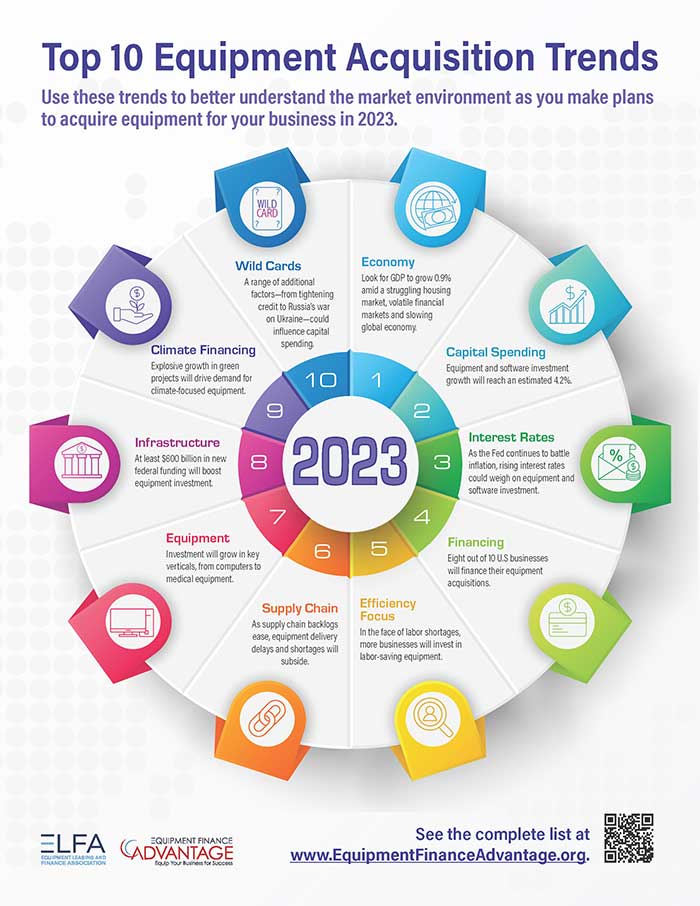Equipment and software are a big investment. Should you rent? Should you buy? How do you tap into all that data that exists? Taking a closer look at some of the biggest trends can help businesses make more informed decisions.
Recently the ELFA (Equipment Leasing and Finance Assn.) released its list of Top 10 Equipment Acquisition Trends for 2023. These trends were compiled through industry research, industry participants’ expertise, and member input. The objective is to help businesses as they execute their equipment acquisition strategies.
Let’s dig into the numbers. Real private investment by U.S. businesses in equipment and software is forecast to be more than $2 trillion in 2023, with a substantial amount of that investment activity financed, so these trends impact a significant portion of the U.S. economy.
With all this in mind, the following top 10 equipment acquisition trends for 2023 include:
1. The U.S. economy will see sluggish growth in 2023, due to a struggling housing market, volatile financial markets, and a sagging economy. The organization points to a mild recession to begin midway through the year, with U.S. GDP growth forecast at 0.9% annualized for 2023.
2. Growth in capital spending will begin to slow, following steady growth since the onset of the pandemic. We saw a surge of 12% annualized growth in capital spending in Q3 2022, which provided a solid jumping-off point for 2023. But high inflation, rising interest rates, and other economic uncertainties are expected to weigh on investment with 4.2% growth forecast for this year. This could plague growth for the year.
3. Financial conditions will tighten. What’s more, some industries might even begin to feel constrained beyond what has been forecasted. Interest rate levels are expected to rise above 5% this year, and potentially higher as the Fed continues to battle inflation despite the risk of an economic downturn.
4. The majority of equipment acquisitions will be financed, due to protection from equipment obsolescence, tax advantages, and cash flow optimization. In 2023, more than half (55%) of equipment acquisitions are forecast to be financed. Eight out of 10 businesses use leases, secured loans, or lines of credit for their acquisitions.
5. Equipment and software investment will be used to offset labor costs. With a weakening labor pool, businesses recognize digital transformation and automation can improve productivity and downward pressure on inflation in the long term.
6. Normal supply-chain backlogs will ease equipment acquisitions. I have said this many times before, but the pandemic caused a shift where many large organizations are “near-shoring” or “re-shoring” their supply chain. This ELFA prediction suggests supply-chain backlogs have returned to their historical averages and will ease equipment delivery delays or shortages this year. A combination of cooling demand and an improving public health situation have given suppliers a chance to catch up. But the real challenge will be pricing models and what changes will occur as a result.
7. In a post-pandemic world, we will see new demand for certain types of equipment. Post-pandemic hybrid work arrangements will require acquisitions of equipment types such as computers, software, office equipment, and communications equipment.
8. Federal spending will increase equipment investment. Three major bills passed in Congress authorize at least $600 billion in new funding for a variety of industrial and infrastructure projects and should provide a sharp boost to equipment investment. Funding from these bills will be distributed over the next five years and should increase the demand for equipment in 2023 and beyond.
9. Green projects will drive “climate financing.” As I have indicated previously, businesses are looking to cut their production and emissions of greenhouse gases. Equipment such as wind turbines, solar energy systems, microgrids, are gaining momentum. Globally, an estimated $18 trillion of climate-focused equipment is forecast to be financed between now and 2030. Perhaps the bigger question we should all be asking is how effective will they be in delivering on the promise by 2030? Or should we begin altering our projections to be more in line with realistic targets?
10. Many “wild cards” will also factor into business investment decisions. ELFA suggests businesses will keep an eye on other areas that could impact their equipment acquisition strategies such as tightening credit, a potential debt-ceiling showdown in Congress, and energy price increases due to Russia’s war on Ukraine, or other international entanglements that might arise within the decade.

Many of these predictions are ones I have written about here in this blog in the past several months. Are you seeing and experiencing the same shifts? What is impacting your investment decisions? Do you plan to acquire or finance more equipment and software in the year ahead as a result of what has been discussed?
Want to tweet about this article? Use hashtags #IoT #sustainability #AI #5G #cloud #edge #futureofwork #digitaltransformation #green #ecosystem #environmental #circularworld


